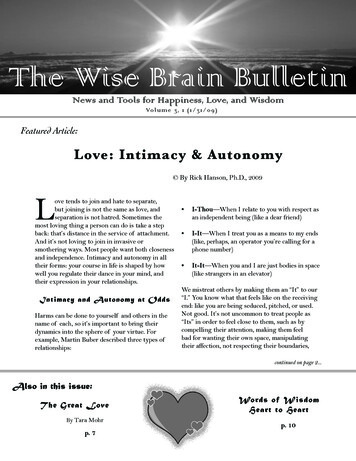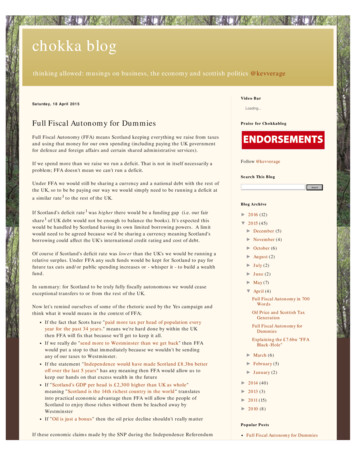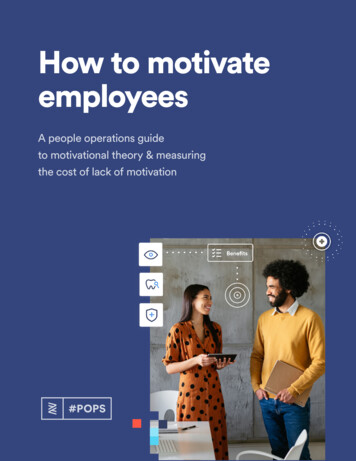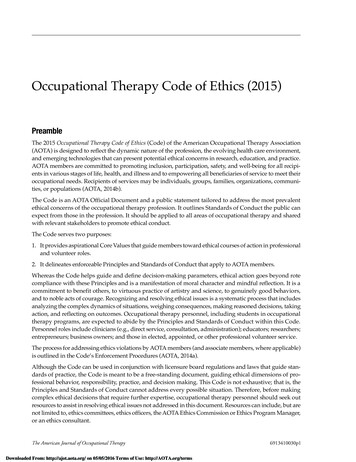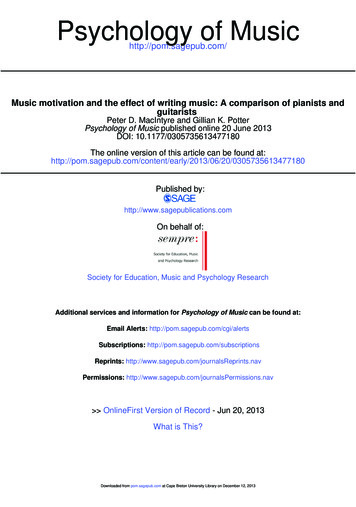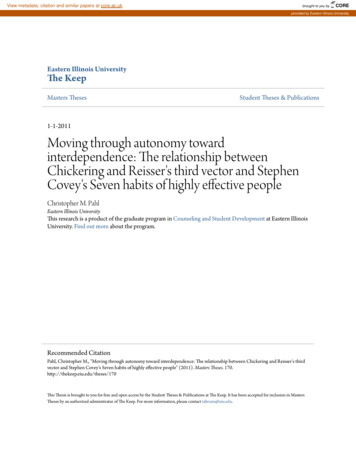
Transcription
View metadata, citation and similar papers at core.ac.ukbrought to you byCOREprovided by Eastern Illinois UniversityEastern Illinois UniversityThe KeepMasters ThesesStudent Theses & Publications1-1-2011Moving through autonomy towardinterdependence: The relationship betweenChickering and Reisser's third vector and StephenCovey's Seven habits of highly effective peopleChristopher M. PahlEastern Illinois UniversityThis research is a product of the graduate program in Counseling and Student Development at Eastern IllinoisUniversity. Find out more about the program.Recommended CitationPahl, Christopher M., "Moving through autonomy toward interdependence: The relationship between Chickering and Reisser's thirdvector and Stephen Covey's Seven habits of highly effective people" (2011). Masters Theses. 170.http://thekeep.eiu.edu/theses/170This Thesis is brought to you for free and open access by the Student Theses & Publications at The Keep. It has been accepted for inclusion in MastersTheses by an authorized administrator of The Keep. For more information, please contact tabruns@eiu.edu.
*****US Copyright Notice*****No further reproduction or distribution of this copyis permitted by electronic transmission or any othermeans.The user should review the copyright notice onthe following scanned image(s) contained in theoriginal work from which this electronic copy wasmade.Section 108: United States Copyright LawThe copyright law of the United States [Title 17,United States Code] governs the making ofphotocopies or other reproductions of copyrightedmaterials.Under certain conditions specified in the law,libraries and archives are authorized to furnish aphotocopy or other reproduction. One of thesespecified conditions is that the reproduction is not tobe used for any purpose other than private study,scholarship, or research. If a user makes a requestfor, or later uses, a photocopy or reproduction forpurposes in excess of "fair use," that use may beliable for copyright infringement.This institution reserves the right to refuse toaccept a copying order if, in its judgment, fulfillmentof the order would involve violation of copyright law.No further reproduction and distribution of this copy ispermitted by transmission or any other means.
Page 1 of 1Thesis Reproduction CertificateTHESIS MAINTENANCE AND REPRODUCTION CERTIFICATETO: Graduate Degree Candidates (who have written formal theses)SUBJECT: Permission to Reproduce ThesesThe University Library is receiving a number of request from other institutions asking permission to reproducedissertations for inclusion in their library holdings. Although no copyright laws are involved, we feel thatprofessional courtesy demands that permission be obtained from the author before we allow these to becopied.PLEASE SIGN ONE OF THE FOLLOWING STATEMENTS:Booth Library of Eastern Illinois University has my permission to lend my thesis to a reputable college oruniversity for the purpose of copying it for inclusion in that institution's library or research holdings.2/251 I \Author's SignatureDateI respectfully request Booth Library of Eastern Illinois University NOT allow my thesis to be reproducedbecause:Author's SignatureDateThis form must be submitted in reproductioncert.html2/25/2011
Moving Through Autonomy Toward Interdependence: The Relationship Between ChickeringAnd Reisser's Third Vector and Stephen Covey's Seven Habits of Highly Effective People(TITLE)BYChristopher M. PahlTHESISSUBMITTED IN PARTIAL FULFILLMENT OF THE REQUIREMENTSFOR THE DEGREE OFMaster of Science in College Student AffairsIN THE GRADUATE SCHOOL, EASTERN ILLINOIS UNIVERSITYCHARLESTON, ILLINOISMay 2011YEARI HEREBY RECOMMEND THAT THIS THESIS BE ACCEPTED AS FULFILLINGTHIS PART OF THE GRADUATE DEGREE CITED ABOVE (. '-fo THESIS COMMITTEE MEMBERDEPARTMENT/SCHOOL CHAIROR CHAIR'S DESIGNEEDATE ATETHESIS COMMITTEE MEMBERDATEDATETHESIS COMMITTEE MEMBERDATEl!a to 1/Ics &-THESISCMMITTEE MEMBER
DedicationI want to dedicate this thesis to my godson and nephew Brady Pahl. He is almosttwo years old saying "thesis" and "good luck", his presence in my life has made me domy best and to lead by example so he knows he can achieve anything he puts his mind toaccomplish.
iiAcknowledgementsI want to thank my advisor Dr. Charles Eberly. Without his continuous supportand hours of office time, I could not have been able to complete this thesis. I would alsolike to thank my other committee members, lody Stone and Dr. Stephen Lucas. Theyhave put in many hours of their own time to ensure I complete this thesis and succeed inmy graduate studies.I would also like to thank my entire family including my mother Debbie, fatherBruce, brother Ben and sister-in-law Nicole. They have taken the time to encourage andsupport me every step of the way while working on my thesis.To my supervisor, Michelle Hopper, whom I cannot thank enough for dedicatingtwo years of her life to act as a mentor in student affairs while pushing to complete mythesis. I would also like to thank my friends and co-workers at Eastern Illinois Universityfor their unconditional support.I have been fortunate to have a loving, caring and supportive girlfriend, KateSchmidt, who has pushed me to do my best and be a true motivation to fmish this thesis.
iiiAbstractThis study assessed college student levels of autonomy as measured by The IowaDeveloping Autonomy Inventory (Hood & Jackson, 1986), and their perception of theirmastery of the seven habits of highly effective people as measured by the Covey SevenHabits Self Profile (Covey, ND) . The Iowa inventory consists of six subscales consistingof 15 items each; mobility, time management, money management, interdependence,emotional independence - Peers and emotional independence - Parents. The Seven Habitsprofile consists of nine three-item categories; emotional bank account, life balance, beproactive, begin with the end in mind, put fIrst things frrst, think win-win, seek frrst tounderstand, synergize, and sharpen the saw.Two-tailed t-tests were used to measure signifIcant differences between maleand female students, freshmen and senior students, and students living on or off-campuson the two measures. A series of Pearson Product Moment correlations were calculated toexamine correlations between the Iowa Developing Autonomy Inventory scales andCovey's Seven Habits categories.Significant differences were found between male and female students, freshmenand senior students and students living on or off-campus on The Iowa DevelopingAutonomy Scale. Few significant differences were found between male and femalestudents, freshmen and senior students and living on or off-campus as measured by theCovey Seven Habits Self Profile. There were 33 signifIcant correlations between theSeven Habits measure and the six Iowa Developing Autonomy subscales.
ivTable of ContentsDedication . iAcknowledgenlents . iiAbstract . iiiList of Appendixes .viChapter I - Introduction. 1Purpose oj'Study . 2Research Question and Hypotheses .2Significance ofthe Study . 6Definitions ofTerms . 7Chapter Summary . 9Chapter II - Literature Review . 10The Seven Habits . 10Chickering and Riesser 's Student Development Theory . . 16The Iowa Student Development Inventories . 17Related Development Research . 18Chapter Summary . 20CHAPTER III - Methodology . 21Site Selection . . 21Research Participants . 22Instrumentation . 22Research Design and Assumptions . 24Data Collection . . 24Data Analysis . 25Chapter Summary . 26Chapter IV - Results . 27Internal Consistency Reliability . 27Population and Response Rate . 28Descriptive Statistics - Iowa Developing Autonomy Inventory . 28Descriptive Statistics - Seven Habits Self Profile .29Differences between Males and Females - Iowa Developing Autonomy Inventory . 30
vDifferences between Male and Females - SelfProfile .31Differences between Freshmen and Seniors - Iowa Developing Autonomy Inventory .32Differences between Freshmen and Seniors - Covey SelfProfile . .33Differences between On and Off Campus Living - Iowa Developing AutonomyInventory. 35D(lferences between On and Off Campus Living - Covey Self Profile . 36Correlations ofSeven Habits ofHighly Effective People and Iowa DevelopingAutonomy . .37Inventory . 37Chapter Summary . 39Chapter V - RecornmendationiDiscusioniConcultion . .42Discussion. .42Differences between Males and Females . .43Differences between Freshmen and Seniors. .44Differences between Living On and Off-Campus . .45Relation between Chickering'S Third Vector and the Seven Habits of HighlyEffective People . 47Recommendationsfrom the Results ofthe Present Study . 52Recommendations for Future Research . 53Conclusion . 54References . 56Appendixes . 61
viList of AppendixesA. Iowa Developing Autonomy Inventory . 61B. Seven Habits Self-Scoring Survey . 67C. Present Study Instrument . 68D. Informed Consent . 71F. CombachAlpha . 73G. IRB Approval . 74
1Chapter IIntroductionStudent affairs professionals seek to understand what "knowledge, skills, anddesires" (Covey, 1989, p. 44) influence individual student development. Numerousstudent development theories are related to Erickson's (1964) work on adolescent identitydevelopment. Chickering (1972) expanded Erickson's adolescent stage of "identityversus role confusion" (Erikson, 1964, p. 261) into seven vectors, each exploring steps acollege student takes in their journey through college toward adulthood. Many studieshave demonstrated the validity of these theories (Pascarella & Terenzini, 1991,2005),showing that students do in fact develop along specific vectors over the course of theircollege years, but what habits of behavior they have learned from their experiences is notwell understood. Are students leaving with the interpersonal skills needed to enter theworkforce and be effective in their role as an employee?Chickering and Reisser's (1993) third vector, "moving through autonomy towardinterdependence" (p. 115), may be a useful way to measure if students learn thedevelopmental skills associated with being effective in their work roles. Moving throughautonomy toward interdependence focuses on "freedom from continual and pressingneeds for reassurance, affection, or approval from others" (p.117). As a high schoolstudent enters college, they are accustomed to having "reassurance, affection andapproval from close friends and family" (p.117). Students moving through college learnto develop new coping skills to move into interdependence so they can be effective on
2their own. Thus, the question becomes, what skills are learned to achieve this successfulstep into interdependence?The Seven Habits ofHighly Effective People (Covey, 1989) focus on the lifechanges associated with moving from dependence to interdependence. Covey's thesispinpointed how mastering these seven habits allowed a person to move from being adependent person to becoming self-confidently interdependent. Many people who havesuccessfully implemented these habits into their own daily life attest to their value(Haimes, 2001; Lambert & Milner, 2008).Purpose ofStudyBoth Chickering and Reisser's (1993) third vector and Covey's seven habits addressthe process of moving from dependence to interdependence. The purpose of the presentstudy was to ascertain the relationship between a measure of Chickering'S third vector,moving through autonomy toward interdependence, and a measure of Covey's sevenhabits of highly effective people. Chickering's third vector was measured using The IowaDeveloping Autonomy Inventory (Hood & Jackson, 1986) and a measure of the sevenhabits was accessed via the Seven Habits Profile (Seven Habits Self Profile,http://www.franklincovey.comltc/resources. retrieved March 22,2010).Research Question and HypothesesFour general research questions were developed for the purpose of the present studyalong with statistical hypotheses based on the review ofliterature related to the researchquestions. Research questions and associated hypotheses are stated below.
31) Are there differences between male and female college students in the subscalesof mobility, time management, money management, interdependence, emotionalindependence - Peers and emotional independence - parents as measured by theIowa Developing Autonomy Inventory (Hood & Jackson, 1986)?Hoi: There will be no statistically significant differences in mean scores on thesubscales of the Iowa Developing Autonomy Inventory between male andfemale college students.Hal: There will be statistically significant differences in mean scores on thesubscales of the Iowa Developing Autonomy Inventory between male andfemale co lIege students.2) Are there differences between male and female college students in the habitsbeing proactive, beginning with the end in mind, putting fITst things fITst, thinkingwin-win, seeking fITst to understand, synergy, sharpening the saw as measured bySteven Covey's Seven Habit Self Scoring Profile (Covey, NA)?Ho2 : There will be no statistically significant differences in mean scores on theSeven Habits of the Seven Habit Self Scoring Profile between male andfemale college students.H a2 : There will be statistically significant differences in mean scores on theSeven Habits of the Seven Habit Self Scoring Profile between male andfemale college students.3) Are there differences between freshmen and senior college students in thesubscales of mo bility, time management, money management, interdependence,
4emotional independence - Peers and emotional independence - parents asmeasured by the Iowa Developing Autonomy Inventory (Hood & Jackson, 1986) 7Ho3: There will be no statistically significant differences in mean scores on thesubscales of the Iowa Developing Autonomy Inventory between freshmen andsenior college students.Ha3: There will be statistically significant differences in mean scores on thesubscales of the Iowa Developing Autonomy Inventory between freshmen andsenior college students.4) Are there differences between freshmen and senior college students in the habitsof being proactive, beginning with the end in mind, putting first things first,thinking win-win, seeking first to understand, synergy, sharpening the saw asmeasured by Steven Covey's Seven Habit Self Scoring Profile (Covey, NA)7Ho4 : There will be no statistically significant differences in mean scores on theSeven Habits of the Seven Habit Self Scoring Profile between freshmen andsenior college students.H a4 : There will be statistically significant differences in mean scores on theSeven Habits of the Seven Habit Self Scoring Profile between freshmen andsenior college students.5) Are there differences between college students living on-campus and collegestudents living off-campus in the subscales of mobility, time management, moneymanagement, interdependence, emotional independence - Peers and emotionalindependence - parents as measured by the Iowa Developing AutonomyInventory (Hood & Jackson, 1986)7
5Hos: There will be no statistically significant differences in mean scores on thesubscales of the Iowa Developing Autonomy Inventory between collegestudents living on-campus and college students living off-campus.HaS: There will be statistically significant differences in mean scores on thesubscales ofthe Iowa Developing Autonomy Inventory between collegestudents living on-campus and college students living off-campus.6) Are there differences between college students living on-campus and collegestudents living off-campus in the habits of being proactive, beginning with theend in mind, putting first things first, thinking win-win, seeking first tounderstand, synergy, sharpening the saw as measured by Steven Covey's SevenHabit Self Scoring Profile (Covey, NA)?Ho4 : There will be no statistically significant differences in mean scores on theSeven Habits of the Seven Habit Self Scoring Profile between college studentsliving on-campus and college students living off-campus.Ha4: There will be statistically significant differences in mean scores on theSeven Habits ofthe Seven Habit Self Scoring Profile between college studentsliving on-campus and college students living off-campus.7) Is there a relationship between the subscales of mobility, time management,money management, interdependence, emotional independence - Peers andemotional independence - parents as measured by the Iowa DevelopingAutonomy Inventory (Hood & Jackson, 1986) and the habits being proactive,beginning with the end in mind, putting first things first, thinking win-win,
6seeking fIrst to understand, synergy, sharpening the saw as measured by StevenCovey's Seven Habit Self Scoring ProfIle (Covey, NA)?Ho7: There will be no statistically significant correlations between thesubscales of mobility, time management, money management,interdependence, emotional independence - Peers and emotional independence- parents as measured by the Iowa Developing Autonomy Inventory (Hood &Jackson, 1986) and the habits being proactive, beginning with the end inmind, putting fIrst things fIrst, thinking win-win, seeking first to understand,synergy, sharpening the saw as measured by Steven Covey's Seven Habit SelfScoring ProfIle (Covey, NA).Ha7: There will be statistically signifIcant correlations between the subscalesof mobility, time management, money management, interdependence,emotional independence - Peers and emotional independence - parents asmeasured by the Iowa Developing Autonomy Inventory (Hood & Jackson,1986) and the habits being proactive, beginning with the end in mind, puttingfirst things first, thinking win-win, seeking fIrst to understand, synergy,sharpening the saw as measured by Steven Covey's Seven Habit Self ScoringProfile (Covey, NA).Significance ofthe StudyThis study has the potential to have a strong impact in higher education. As a newgeneration enters college, it will be important to find effective ways to facilitate theircognitive and psychosocial development. By knowing relationships between recognizedstudent development theories (Chickering and Riesser, 1993) and contemporary
7management theories (Covey, 1989), student affairs professionals and their instructionalcolleagues can acquire an integrative learning activity focusing on living/learninginitiatives and classroom instructional procedures that promote healthy studentdevelopment.Definitions ofTermsThe following defmition of terms includes concepts important to theunderstanding of the present study.Autonomy: "Social-cognitive theorists have similarly depicted autonomy as a freedomfrom external influences" (Ryan & Deci, 1989, p. 5060).Begin with the end in mind: Covey (1989) said that successfully creating long termmeasurable goals was based on personal principles and beginning the process by keepingthe end in mind.Be proactive: Covey (1989) explained being proactive as change starting from withinand to make decisions to improve lives through influence, rather than by reacting toexternal forces.Dependent: "Dependent people need others to get what they want" (Covey, 1989, p. 49).Emotional independence: Chickering and Reisser (1993) defended emotionalindependence as "Freedom from continual and pressing needs for reassurance, affection,or approval from others" (p. 117).Habit: "A habit can be defined as an intersection ofknowledge, skill and desire" (Covey,1989, p. 47).
8Independence: Chickering and Reisser (1993) defmed independence as, "the ability tocarryon activities and solve problems in a self-directed manner, and the freedom andconfidence to be mobile in order to pursue opportunity and adventure" (p. 117)Interdependence: Evens, al et., (2010) defmed interdependence as. "An awareness ofinterconnectedness with others" (p. 68).Mobility: "Independence involves literal mobility [meaning] the ability to leave oneplace and get to another, to leave a bad situation and arrive safely at a better one"(Chickering and Reisser, 1993, p. 138)Money management: Money management is defined by, "the process of knowing whereyou are spending your money today, and having a well thought-out plan in place forwhere you want it to go" (balancetrack.org, 2010).Put first things first: "First things are those things you, personally, find of most worth.If you put first things first, you are organizing and managing time and events according tothe personal priorities" (Covey, 1989. p. 147)Think win-win: Seek agreements and relationships that are mutually beneficial (Covey,1989).Time management: "Time management is going to mean the development of a processand tools that help you be more productive and harpening the saw: Covey (1989) explains someone who takes the time to buildpersonal renewal of the physical, mental, social/emotional, and spiritual dimensions assomeone who is sharpening the saw.
9Seek first to understand, then be understood: Covey (1989) describes "seek first tounderstand, then be understood" (p. 235) as having the ability to first seek to understandthe other person and then try to be understood.Synergy: "Synergy is defined as to create a whole that is greater than the sum of theparts" (Covey, 1989, p. 262).Chapter SummaryChapter I contained the question of any potential relationship between twotheories (Covey and Chickering) of personal development and outlined the purpose of thepresent study and research questions which guided the study. Chapter II is a review ofresearch and popular literature regarding the use and development of both theories, TheSeven Habits of Highly Effective people and Chickering and Riesser's (1993) thirdvector, "moving through autonomy toward interdependence" (p. 115). Chapter II alsoincludes literature pertaining to a student's development based on class rank, thestudent's sex and the student's residence. Chapter III contains the methodology,procedures for data collection and analysis. Chapter IV contains the research fmdings.Chapter V contains a discussion ofthe research fmdings, applications for professionaland academic practice, conclusions drawn, and recommendations for future researchers inthe area of college students and student development.
10Chapter IILiterature ReviewThe literature review for the current study assessing the relationship between TheSeven Habits of Highly Effective People and Chickering's third vector, moving throughautonomy toward interdependence, addressed four broad areas: an introduction to theseven habits, Chickerings student development theory, the Iowa student developmentinventories, a measure of Chickering's vectors, and related developmental theoriesfocusing on autonomy,. The seven habits section defined The Seven Habits of HighlyEffective people according to Covey and practical applications of the seven habits ineducational and personal settings. Literature reviewed also highlighted selected theoriesof student development focusing on autonomy. A section dedicated to The Iowa StudentDevelopment Inventories addressed what the inventories are and the validity behind eachof them. These four areas were broad, but are all equally important in developing aframework to asses if the seven habits are being effectively learned through a student'sjourney through college.The Seven HabitsOver 15 million copies of The Seven Habits ofHighly Effective People have beensold (Covey, 1989). Covey defined habits as ''the intersection of knowledge, skill anddesire" (p. 47), in other words knowledge is what to/why to do something, the skill is thehow to do something, and the desire is the want to do something. The seven habits focus
11on the journey from dependence to interdependence. Habits 1 through 3 address thestages of dependence, habits 3 and four address the stages of independence, and habits 4through 7 address the stages of interdependence. The first three habits focus on self.Habit one details the importance of becoming proactive; underscoring the need to notfInd oneself sitting around and waiting to be told to do something and provide theinitiative. Habit two is "to begin with the end in mind." (Covey, 1989, 97) Set goals foryourself, aim for them and establish a sense of direction as a leader (Covey, 1992). Habitthree is defIned as "put first things first" (Covey, 1989, pp.145), and this habit focuses ontime management skills to accomplish tasks in ter,ms of priority. Habits four through sixfocuses on interdependence; Habit four focuses on "win/win" (Covey, 1989, pp.204)situations. Find that middle ground where no one will lose; it's all about the power ofconsidering compromise. Covey's habit five deals with empathic communication; "seekfrrst to understand, then to be understood" (Covey, 1989, pp.235). Take the time to listento others and understand what they want so that you will be able to talk back and be moreeasily understood. Habit six talks about synergy; synergy is a concept where the energyfrom everyone is used to come up with the best idea possible. Habit seven focuses onrenewal. Covey looks at the analogy "Sharpen the saw" (Covey, 1989, pp. 287) byreviewing the past six habits and applies it through self improvement for the future(Covey, 1992).In an interview, Covey (1994) explained why he thought the seven habits areimportant and why he believed they are effective. In the interview, Covey was questionedabout the difference
mastery ofthe seven habits of highly effective people as measured by the Covey Seven Habits Self Profile (Covey, ND) . The Iowa inventory consists of six subscales consisting of 15 items each; mobility, time management, money management, interdependence, emotional independence -Peers and emotional
